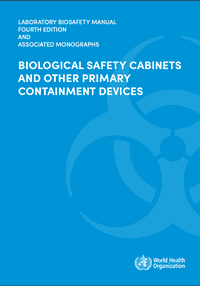LBM, 4th Edition: Biological Safety Cabinets and Other Primary Containment Devices Monograph
[LBM 4: BSCs and Other Primary Containment Devices]
One of seven monographs associated with the 4th edition of the WHO LBM. This monograph covers biological safety cabinets (BSCs), ventilated workspaces designed to keep biological materials contained and researchers safe. This monograph describes several BSCs and guides readers through selecting the one most appropriate to their use case.
SUMMARY
The Biological Safety Cabinets and other primary containment devices monograph covers biological safety cabinets (BSCs), ventilated workspaces designed to keep biological materials contained and researchers safe. This monograph describes several BSCs and guides readers through selecting the one most appropriate to their use case. BSCs are crucial to biosafety because they protect personnel and have been shown to reduce laboratory-associated infections. BSCs used directed airflow to ensure that dangerous aerosols are directed away from researchers and filtered out before the air is exhausted from the device or laboratory. The creation of this monograph was funded by Global Affairs Canada, the United States Department of State and the United States Defense Threat Reduction Agency.
This monograph was one of seven associated with the 4th edition of the WHO Laboratory Biosafety Manual (LBM). The LBM guidelines have been globally recognized as a fundamental resource for laboratory biosafety since the first edition was released in 1983. While the standards outlined in this manual are not legally binding, they have become the defacto global standard for biosafety and have inspired many national codes. These guidelines are developed with experts from around the world, and were most recently updated for the fourth edition in 2020, which places a larger emphasis on an evidence and risk based approach to biosafety and biosecurity. Previous editions of the manual have been published in 13 languages, although, as of the last time this library was updated, the 4th edition was only available in English. The development of the manual is led by the Biosecurtity and Health Security Interface at the WHO, a team who also supports national implementation efforts of the International Health Regulations and emergency preparedness.


..png)
